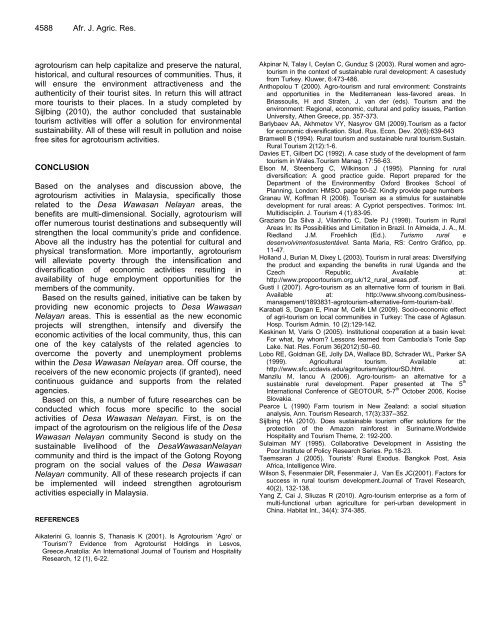Socio-economic impact potential of agro tourism activities on Desa ...
Socio-economic impact potential of agro tourism activities on Desa ...
Socio-economic impact potential of agro tourism activities on Desa ...
You also want an ePaper? Increase the reach of your titles
YUMPU automatically turns print PDFs into web optimized ePapers that Google loves.
4588 Afr. J. Agric. Res.<br />
<str<strong>on</strong>g>agro</str<strong>on</strong>g><str<strong>on</strong>g>tourism</str<strong>on</strong>g> can help capitalize and preserve the natural,<br />
historical, and cultural resources <str<strong>on</strong>g>of</str<strong>on</strong>g> communities. Thus, it<br />
will ensure the envir<strong>on</strong>ment attractiveness and the<br />
authenticity <str<strong>on</strong>g>of</str<strong>on</strong>g> their tourist sites. In return this will attract<br />
more tourists to their places. In a study completed by<br />
Sijlbing (2010), the author c<strong>on</strong>cluded that sustainable<br />
<str<strong>on</strong>g>tourism</str<strong>on</strong>g> <str<strong>on</strong>g>activities</str<strong>on</strong>g> will <str<strong>on</strong>g>of</str<strong>on</strong>g>fer a soluti<strong>on</strong> for envir<strong>on</strong>mental<br />
sustainability. All <str<strong>on</strong>g>of</str<strong>on</strong>g> these will result in polluti<strong>on</strong> and noise<br />
free sites for <str<strong>on</strong>g>agro</str<strong>on</strong>g><str<strong>on</strong>g>tourism</str<strong>on</strong>g> <str<strong>on</strong>g>activities</str<strong>on</strong>g>.<br />
CONCLUSION<br />
Based <strong>on</strong> the analyses and discussi<strong>on</strong> above, the<br />
<str<strong>on</strong>g>agro</str<strong>on</strong>g><str<strong>on</strong>g>tourism</str<strong>on</strong>g> <str<strong>on</strong>g>activities</str<strong>on</strong>g> in Malaysia, specifically those<br />
related to the <strong>Desa</strong> Wawasan Nelayan areas, the<br />
benefits are multi-dimensi<strong>on</strong>al. Socially, <str<strong>on</strong>g>agro</str<strong>on</strong>g><str<strong>on</strong>g>tourism</str<strong>on</strong>g> will<br />
<str<strong>on</strong>g>of</str<strong>on</strong>g>fer numerous tourist destinati<strong>on</strong>s and subsequently will<br />
strengthen the local community‟s pride and c<strong>on</strong>fidence.<br />
Above all the industry has the <str<strong>on</strong>g>potential</str<strong>on</strong>g> for cultural and<br />
physical transformati<strong>on</strong>. More importantly, <str<strong>on</strong>g>agro</str<strong>on</strong>g><str<strong>on</strong>g>tourism</str<strong>on</strong>g><br />
will alleviate poverty through the intensificati<strong>on</strong> and<br />
diversificati<strong>on</strong> <str<strong>on</strong>g>of</str<strong>on</strong>g> <str<strong>on</strong>g>ec<strong>on</strong>omic</str<strong>on</strong>g> <str<strong>on</strong>g>activities</str<strong>on</strong>g> resulting in<br />
availability <str<strong>on</strong>g>of</str<strong>on</strong>g> huge employment opportunities for the<br />
members <str<strong>on</strong>g>of</str<strong>on</strong>g> the community.<br />
Based <strong>on</strong> the results gained, initiative can be taken by<br />
providing new <str<strong>on</strong>g>ec<strong>on</strong>omic</str<strong>on</strong>g> projects to <strong>Desa</strong> Wawasan<br />
Nelayan areas. This is essential as the new <str<strong>on</strong>g>ec<strong>on</strong>omic</str<strong>on</strong>g><br />
projects will strengthen, intensify and diversify the<br />
<str<strong>on</strong>g>ec<strong>on</strong>omic</str<strong>on</strong>g> <str<strong>on</strong>g>activities</str<strong>on</strong>g> <str<strong>on</strong>g>of</str<strong>on</strong>g> the local community, thus, this can<br />
<strong>on</strong>e <str<strong>on</strong>g>of</str<strong>on</strong>g> the key catalysts <str<strong>on</strong>g>of</str<strong>on</strong>g> the related agencies to<br />
overcome the poverty and unemployment problems<br />
within the <strong>Desa</strong> Wawasan Nelayan area. Off course, the<br />
receivers <str<strong>on</strong>g>of</str<strong>on</strong>g> the new <str<strong>on</strong>g>ec<strong>on</strong>omic</str<strong>on</strong>g> projects (if granted), need<br />
c<strong>on</strong>tinuous guidance and supports from the related<br />
agencies.<br />
Based <strong>on</strong> this, a number <str<strong>on</strong>g>of</str<strong>on</strong>g> future researches can be<br />
c<strong>on</strong>ducted which focus more specific to the social<br />
<str<strong>on</strong>g>activities</str<strong>on</strong>g> <str<strong>on</strong>g>of</str<strong>on</strong>g> <strong>Desa</strong> Wawasan Nelayan. First, is <strong>on</strong> the<br />
<str<strong>on</strong>g>impact</str<strong>on</strong>g> <str<strong>on</strong>g>of</str<strong>on</strong>g> the <str<strong>on</strong>g>agro</str<strong>on</strong>g><str<strong>on</strong>g>tourism</str<strong>on</strong>g> <strong>on</strong> the religious life <str<strong>on</strong>g>of</str<strong>on</strong>g> the <strong>Desa</strong><br />
Wawasan Nelayan community Sec<strong>on</strong>d is study <strong>on</strong> the<br />
sustainable livelihood <str<strong>on</strong>g>of</str<strong>on</strong>g> the <strong>Desa</strong>WawasanNelayan<br />
community and third is the <str<strong>on</strong>g>impact</str<strong>on</strong>g> <str<strong>on</strong>g>of</str<strong>on</strong>g> the Got<strong>on</strong>g Roy<strong>on</strong>g<br />
program <strong>on</strong> the social values <str<strong>on</strong>g>of</str<strong>on</strong>g> the <strong>Desa</strong> Wawasan<br />
Nelayan community. All <str<strong>on</strong>g>of</str<strong>on</strong>g> these research projects if can<br />
be implemented will indeed strengthen <str<strong>on</strong>g>agro</str<strong>on</strong>g><str<strong>on</strong>g>tourism</str<strong>on</strong>g><br />
<str<strong>on</strong>g>activities</str<strong>on</strong>g> especially in Malaysia.<br />
REFERENCES<br />
Aikaterini G, Ioannis S, Thanasis K (2001). Is Agro<str<strong>on</strong>g>tourism</str<strong>on</strong>g> „Agro‟ or<br />
„Tourism‟? Evidence from Agrotourist Holdings in Lesvos,<br />
Greece.Anatolia: An Internati<strong>on</strong>al Journal <str<strong>on</strong>g>of</str<strong>on</strong>g> Tourism and Hospitality<br />
Research, 12 (1), 6-22.<br />
Akpinar N, Talay I, Ceylan C, Gunduz S (2003). Rural women and <str<strong>on</strong>g>agro</str<strong>on</strong>g><str<strong>on</strong>g>tourism</str<strong>on</strong>g><br />
in the c<strong>on</strong>text <str<strong>on</strong>g>of</str<strong>on</strong>g> sustainable rural development: A casestudy<br />
from Turkey. Kluwer, 6:473-486.<br />
Anthopolou T (2000). Agro-<str<strong>on</strong>g>tourism</str<strong>on</strong>g> and rural envir<strong>on</strong>ment: C<strong>on</strong>straints<br />
and opportunities in the Mediterranean less-favored areas. In<br />
Briassoulis, H and Straten, J. van der (eds). Tourism and the<br />
envir<strong>on</strong>ment: Regi<strong>on</strong>al, <str<strong>on</strong>g>ec<strong>on</strong>omic</str<strong>on</strong>g>, cultural and policy issues, Panti<strong>on</strong><br />
University, Athen Greece, pp. 357-373.<br />
Barlybaev AA, Akhmetov VY, Nasyrov GM (2009).Tourism as a factor<br />
for <str<strong>on</strong>g>ec<strong>on</strong>omic</str<strong>on</strong>g> diversificati<strong>on</strong>. Stud. Rus. Ec<strong>on</strong>. Dev. 20(6):639-643<br />
Bramwell B (1994). Rural <str<strong>on</strong>g>tourism</str<strong>on</strong>g> and sustainable rural <str<strong>on</strong>g>tourism</str<strong>on</strong>g>.Sustain.<br />
Rural Tourism 2(12):1-6.<br />
Davies ET, Gilbert DC (1992). A case study <str<strong>on</strong>g>of</str<strong>on</strong>g> the development <str<strong>on</strong>g>of</str<strong>on</strong>g> farm<br />
<str<strong>on</strong>g>tourism</str<strong>on</strong>g> in Wales.Tourism Manag. 17:56-63.<br />
Els<strong>on</strong> M, Steenberg C, Wilkins<strong>on</strong> J (1995). Planning for rural<br />
diversificati<strong>on</strong>: A good practice guide. Report prepared for the<br />
Department <str<strong>on</strong>g>of</str<strong>on</strong>g> the Envir<strong>on</strong>mentby Oxford Brookes School <str<strong>on</strong>g>of</str<strong>on</strong>g><br />
Planning. L<strong>on</strong>d<strong>on</strong>: HMSO. page 50-52. Kindly provide page numbers<br />
Granau W, K<str<strong>on</strong>g>of</str<strong>on</strong>g>fman R (2008). Tourism as a stimulus for sustainable<br />
development for rural areas: A Cypriot perspectives. Torimos: Int.<br />
Multidisciplin. J. Tourism 4 (1):83-95.<br />
Graziano Da Silva J, Vilarinho C, Dale PJ (1998). Tourism in Rural<br />
Areas In: Its Possibilities and Limitati<strong>on</strong> in Brazil. In Almeida, J. A., M.<br />
Riedland J.M. Froehlich (Ed.). Turismo rural e<br />
desenvolvimentosustentável. Santa Maria, RS: Centro Gráfico, pp.<br />
11-47.<br />
Holland J, Burian M, Dixey L (2003). Tourism in rural areas: Diversifying<br />
the product and expanding the benefits in rural Uganda and the<br />
Czech Republic. Available at:<br />
http://www.propoor<str<strong>on</strong>g>tourism</str<strong>on</strong>g>.org.uk/12_rural_areas.pdf.<br />
Gusti I (2007). Agro-<str<strong>on</strong>g>tourism</str<strong>on</strong>g> as an alternative form <str<strong>on</strong>g>of</str<strong>on</strong>g> <str<strong>on</strong>g>tourism</str<strong>on</strong>g> in Bali.<br />
Available at: http://www.shvo<strong>on</strong>g.com/businessmanagement/1893831-<str<strong>on</strong>g>agro</str<strong>on</strong>g><str<strong>on</strong>g>tourism</str<strong>on</strong>g>-alternative-form-<str<strong>on</strong>g>tourism</str<strong>on</strong>g>-bali/.<br />
Karabati S, Dogan E, Pinar M, Celik LM (2009). <str<strong>on</strong>g>Socio</str<strong>on</strong>g>-<str<strong>on</strong>g>ec<strong>on</strong>omic</str<strong>on</strong>g> effect<br />
<str<strong>on</strong>g>of</str<strong>on</strong>g> agri-<str<strong>on</strong>g>tourism</str<strong>on</strong>g> <strong>on</strong> local communities in Turkey: The case <str<strong>on</strong>g>of</str<strong>on</strong>g> Aglasun.<br />
Hosp. Tourism Admin. 10 (2):129-142.<br />
Keskinen M, Varis O (2005). Instituti<strong>on</strong>al cooperati<strong>on</strong> at a basin level:<br />
For what, by whom? Less<strong>on</strong>s learned from Cambodia‟s T<strong>on</strong>le Sap<br />
Lake. Nat. Res. Forum 36(2012):50–60.<br />
Lobo RE, Goldman GE, Jolly DA, Wallace BD, Schrader WL, Parker SA<br />
(1999). Agricultural <str<strong>on</strong>g>tourism</str<strong>on</strong>g>. Available at:<br />
http://www.sfc.ucdavis.edu/agri<str<strong>on</strong>g>tourism</str<strong>on</strong>g>/agritourSD.html.<br />
Manzilu M, Iancu A (2006). Agro-<str<strong>on</strong>g>tourism</str<strong>on</strong>g>- an alternative for a<br />
sustainable rural development. Paper presented at The 5 th<br />
Internati<strong>on</strong>al C<strong>on</strong>ference <str<strong>on</strong>g>of</str<strong>on</strong>g> GEOTOUR, 5-7 th October 2006, Kocise<br />
Slovakia.<br />
Pearce L (1990) Farm <str<strong>on</strong>g>tourism</str<strong>on</strong>g> in New Zealand: a social situati<strong>on</strong><br />
analysis, Ann. Tourism Research, 17(3):337–352.<br />
Sijlbing HA (2010). Does sustainable <str<strong>on</strong>g>tourism</str<strong>on</strong>g> <str<strong>on</strong>g>of</str<strong>on</strong>g>fer soluti<strong>on</strong>s for the<br />
protecti<strong>on</strong> <str<strong>on</strong>g>of</str<strong>on</strong>g> the Amaz<strong>on</strong> rainforest in Suriname.Worldwide<br />
Hospitality and Tourism Theme, 2: 192-200.<br />
Sulaiman MY (1995). Collaborative Development in Assisting the<br />
Poor.Institute <str<strong>on</strong>g>of</str<strong>on</strong>g> Policy Research Series. Pp.18-23.<br />
Taemsaran J (2005). Tourists‟ Rural Exodus. Bangkok Post, Asia<br />
Africa, Intelligence Wire.<br />
Wils<strong>on</strong> S, Fesenmaier DR, Fesenmaier J, Van Es JC(2001). Factors for<br />
success in rural <str<strong>on</strong>g>tourism</str<strong>on</strong>g> development.Journal <str<strong>on</strong>g>of</str<strong>on</strong>g> Travel Research,<br />
40(2), 132‐138.<br />
Yang Z, Cai J, Sliuzas R (2010). Agro-<str<strong>on</strong>g>tourism</str<strong>on</strong>g> enterprise as a form <str<strong>on</strong>g>of</str<strong>on</strong>g><br />
multi-functi<strong>on</strong>al urban agriculture for peri-urban development in<br />
China. Habitat Int., 34(4): 374-385.

















